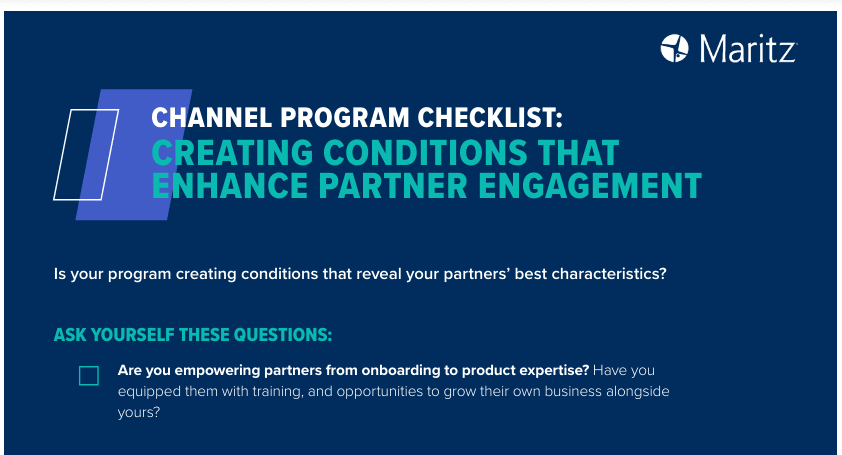
It’s not easy to ditch old ways, especially when it comes to channel program strategies that have worked well enough for long enough. However, partner habits and interests are evolving, and programs will have to keep up in the ever-changing channel industry.
Longevity should always be a focus, which is why we think about incentive strategies a little differently at Maritz. It’s also why behavioral science lays the foundation for every program we build. We’ve been around the block enough times to know what works, but we’ve also surveyed the terrain to test new routes that work even better.
Here’s the trend we’ve noticed: Channel programs that embrace a loyalty-driven, long-term approach to channel incentives see sparks fly. They use proven psychological frameworks to strategize engagement, motivation, retention and performance – and it’s effective.
Partners thrive in programs that prioritize business-building actions, a diverse rewards portfolio and behavior enablement. That’s why our playbooks are designed to foster enduring partnerships, sustain engagement and drive tangible, transformative results.
Still with us? Lean in because we’re about to share EXACTLY how we do it and how you can too.
BUT FIRST…
Did you read the first article in this series about our new holistic approach to incentives? Check it out here and see how we propose to move “beyond the carrot.”
Maritz Incentive Strategy – 4 Key Tenents
1. Beyond the Bribe: Evolving from Transactional Rewards
Traditional incentive models follow a “Do this, Get That” approach. Transactions tend to get prioritized over interactions, meaning incentives and rewards are tied to sales behaviors alone.
Here’s the challenge with this approach: Focusing only on immediate results won’t nurture lasting outcomes.
When we think outside of the narrow lens that solely rewards sales volume, it blows the lid off dated strategies. Why? Because it considers motivation beyond the current moment.
Of course, sales should be celebrated, but the best-performing programs incentivize business-building behaviors that paint a bigger picture of program success.
Fostering customer loyalty, collaborating on marketing efforts, and rewarding partners for doing so are valuable. These programs thrive because they know sales numbers aren’t the only benchmark for measuring quality performance.
Value-Based Action Items:
- Recognize and Reward Progress: Celebrate and honor winning moments throughout the journey, not just when you reach the destination.
- Focus on Behaviors That Build Long-Term Value: Incentivize activities like customer relationship building or co-marketing efforts.
The Science Behind It:
- Motivation is Internal AND External: Transactional rewards and sales-based rebates are external factors that prompt action, or extrinsic motivations. Intrinsic motivators are internally fulfilling actions, such as collaboration and the enjoyment of building relationships. Both are strongest when used together.
2. Incentive Strategies Designed Through a Loyalty Lens
When building a channel incentive program, it’s key to prioritize how you’ll build enduring relationships and sustain engagement. Especially to be successful long-term. That means we need to view programs and objectives through a loyalty lens.
When a strategic blend of incentives and loyalty initiatives come together, so do the best of both worlds. It’s easier to build mutually beneficial partnerships that keep participants engaged and growing the business with you.
Loyalty programs are like incentive programs with a longer-term focus. The difference is that loyalty strategies aim to replace the old “Do This, Get That” incentive model with “Do This, Get MORE. “
When you activate loyalty strategies in your incentive program design, it multiplies the impact of your program to drive results and retain your most valuable partnerships.
Loyalty-Building Action Items:
- Launch Tiered Programs with Increasing Benefits: Offer progressively more attractive rewards as engagement deepens.
- Reward Sales AND Loyalty Behaviors: Reinforce brand advocacy and business-building efforts to cultivate stronger, more committed partners.
- Spark Excitement with Gamification: Integrate points, badges or leaderboards to create a sense of fun and competition in your program.
The Science Behind It:
- We’re Competitive by Nature: Gamification, like points and leaderboards, fosters a sense of competition and accomplishment, making it more thrilling to participate and perform.
- Targets are Magnetic: The Goal Gradient Theory states that the closer people are to a reward, the more motivated they are to reach it. That’s why progress trackers, leaderboards, and tier-based systems work so well to engage partners.
- Status and Mastery are Motivating: Self-worth spikes when we achieve titles and awards, unlock tiers or gain other visible symbols of performance, which manifests as greater motivation to continue advancing goals.
3. A Holistic View of Channel Partner Programs
Successful programs do more than just reward for transactions alone. They go beyond the carrot to include enablement and other engagement drivers of behavior.
Ultimately, a holistic perspective recognizes that behaviors should be not just rewarded but also enabled.
Partners need incentives but, to build something great, they also need the right tools (think product training and marketing materials) and a supportive environment (like clear communication and regular check-ins).
We’ve seen this approach work time and time again to reinforce the right behaviors. All it takes is incorporating other program elements that inspire engagement, such as learning and training, a sense of community, enablement resources and relevant communications.
Empowerment-Focused Action Items:
- Offer Comprehensive Enablement Programs: Equip partners with the knowledge and resources they need to succeed.
- Provide Incentives that Build Businesses: Consider elevating rewards that partners can reinvest into their business, such as marketing dollars, showroom samples, event support and access to training or exclusive products.
The Science Behind It:
- The Journey Matters: Research suggests that focusing on the process of achieving a goal can be more motivating than fixating solely on the outcome, which is why learning and growing along the way fuels partner performance.
- Motivation Needs Three Things: The Self-Determination Theory is a psychological framework that suggests people are most motivated and fulfilled when their needs are met in these three areas: Autonomy (Freedom & Choice), Competence (Skills & Training) and Relatedness (Community & Connection).
4. An Expansive Range of Rewards
Individuals have diverse motivations, and incentive offerings need to align accordingly to get sales partners moving. This is where cash-only programs deserve a quick call out, specifically regarding their limitations.
Monetary reward options are great, and they have their time and place, but options attract interest. When partners can choose from an expansive range of rewards, they gain diverse experiences and more meaningful incentives to motivate their behavior.
Our advice? Look for an incentives portfolio that can flex and be tailored to everyone’s preferences and needs. The most effective reward programs offer a variety of options, and they work to prompt action from a diverse set of partner types.
Reward-Enhancing Action Items:
- Consider Non-Cash Options: Monetary incentives should be incorporated as appropriate, but offering a variety of rewards beyond cash lets you tap into different motivational triggers.
- Cater to Different Motivators: Offer a mix of tangible rewards, intangible rewards and experiential rewards.
- Categorize Your Groups: Create categories that reflect business nuances and individual partner preferences to ensure you’re motivating individuals at the same time as business entities.
The Science Behind It:
- Going Beyond Cash Has an Impact: Research shows advantages of non-cash rewards include higher emotional impact, greater frequency of thought, and added trophy value.
- Experiences Last Longer: Experiences tend to create stronger memories than material goods, which is an opportunity for brands to boost sentimental value and even tap into positive feelings of nostalgia.
- Uniqueness is a Strength: The concept of individual differences is a cornerstone of behavioral science, and learning individual preferences to personalize experiences drives a stronger sense of attachment to brands.
Closing Thoughts
Whether you’re building a program from scratch or refreshing what you have, loyalty is always a good idea. Building it gets a lot easier too when we step into the minds of channel partners to uncover what motivates them and keeps focus on your brand.
Ultimately, when interactions come before transactions, revenue takes care of itself because partners are honed into your objectives, and why wouldn’t they?
If performing in your program means positive encounters, feeling supported to work with a skilled community of peers, and perks that mean something to them – your program isn’t just an option. It’s the place to be.


